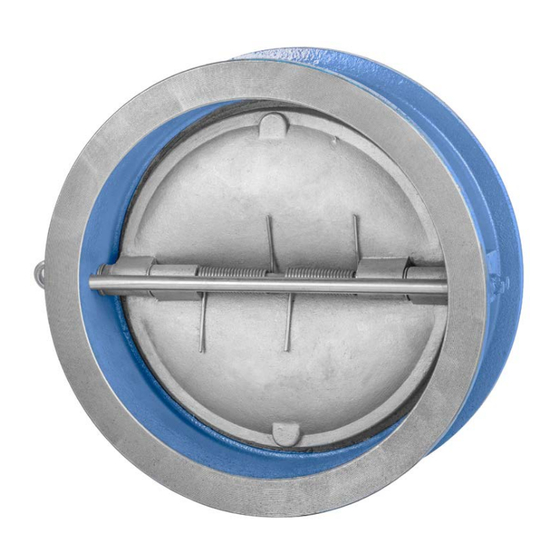DeZurik APCO CDD-9000T Gebruikershandleiding - Pagina 6
Blader online of download pdf Gebruikershandleiding voor {categorie_naam} DeZurik APCO CDD-9000T. DeZurik APCO CDD-9000T 9 pagina's. Double door check valves

DeZURIK
APCO CDD-9000T Double Door Check Valves
Assembly Procedure
See Figure 1 for part identification.
Instructions for valves using pin retainers
1. Clean all ports with a suitable solvent. Trichloroethylene is recommended, particularly for
resilient seated valves.
2. Position doors (2) in body (1), aligning pin holes in the doors with holes in the body.
3. Partially install hinge pin (5). Lateral movement of doors after assembly should not exceed
3/32" in sizes 2 - 12" (50 – 300 mm) and 5/32" for sizes 14" (350 mm) and above.
4. Wind up spring or springs (4) one-half turn to obtain initial torsion and install spring with the
spring arms flat on the doors (2). Do not unwind spring as this will change spring torque and
also limit the opening of the doors. Complete insertion of hinge pin (5).
5. Install stop pin (6) into body (1).
6. Install pin retainers (7) using suitable thread sealant to insure a positive seal.
Instructions for valves using caps
1. Clean all ports with a suitable solvent. Trichloroethylene is recommended, particularly for
resilient seated valves.
2. Position doors (2) together so pin holes in doors are aligned.
3. Slide hinge pin (5) through first pair of door pin holes.
4. Wind up spring or springs (4) one-half turn to obtain initial torsion and install spring with the
spring arms flat on the doors (2). Do not unwind spring as this will change spring torque and
also limit the opening of the doors.
5. Slide hinge pin (5) fully through spring (4) and second pair of door (2) pin holes.
6. Position hinge pin (5) in holes of upper and lower caps (9) at end farthest from end cap flange.
7. Position stop pin in holes of upper and lower caps (9) closest to end cap flange.
8. Position caps (9) next to upper and lower cap grooves in valve body (1) and slide doors (2),
spring (4), pins (5 and 6) and caps (9) fully into place in valve body (1).
9. Tighten caps set screws.
Operation
The Double Door Check Valve is held closed by the legs of a torsion spring. Flow from the pump
causes the Double Door Check Valve to open. Conversely, when the pump is stopped, flow decay
occurs and at a point near zero velocity, the force from the legs of the torsion spring instantly closes the
Double Door Check valve for non-slam shut-off.
D12041
Page 6
September 2015
